Nanopatterning with Photonic Nanojets: Review and Perspectives in Biomedical Research
Abstract
:1. Introduction
2. Photonic Nanojet Formation and Properties
3. Practical Considerations for Nanopatterning
3.1. Light Sources and Illumination Conditions
3.2. Dielectric Microparticle Options
3.3. Scanning Methods
3.4. Nanopatterning with Parallel Photonic Nanojets
4. Nanopatterns for Biomedical Research
4.1. Enabling Results
4.2. Nanostructures for Bio-Applications
4.3. Prospective Bio-Applications
5. Conclusions
Funding
Conflicts of Interest
References
- Tian, B.; Liu, J.; Dvir, T.; Jin, L.; Tsui, J.H.; Qing, Q.; Suo, Z.; Langer, R.; Kohane, D.S.; Lieber, C.M. Macroporous nanowire nanoelectronic scaffolds for synthetic tissues. Nat. Mater. 2012, 11, 872–876. [Google Scholar] [CrossRef] [Green Version]
- Lipani, L.; Dupont, B.G.R.; Doungmene, F.; Marken, F.; Tyrrell, R.M.; Guy, R.H.; Ilie, A. Non-invasive, transdermal, path-selective and specific glucose monitoring via a graphene-based platform. Nat. Nanotechnol. 2018, 13, 504–511. [Google Scholar] [CrossRef] [PubMed]
- Luong-Van, E.; Rodriguez, I.; Low, H.Y.; Elmouelhi, N.; Lowenhaupt, B.; Natarajan, S.; Lim, C.T.; Prajapati, R.; Vyakarnam, M.; Cooper, K. Review: Micro-and nanostructured surface engineering for biomedical applications. J. Mater. Res. 2013, 28, 165–174. [Google Scholar] [CrossRef]
- Kim, D.H.; Lipke, E.A.; Kim, P.; Cheong, R.; Thompson, S.; Delannoy, M.; Suh, K.Y.; Tung, L.; Levchenko, A. Nanoscale cues regulate the structure and function of macroscopic cardiac tissue constructs. Proc. Natl. Acad. Sci. USA 2010, 107, 565–570. [Google Scholar] [CrossRef] [PubMed] [Green Version]
- Convertino, A.; Mussi, V.; Maiolo, L. Disordered array of Au covered Silicon nanowires for SERS biosensing combined with electrochemical detection. Sci. Rep. 2016, 6, 25099. [Google Scholar] [CrossRef] [Green Version]
- Andreeva, D.V.; Sviridov, D.V.; Masic, A.; Möhwald, H.; Skorb, E.V. Nanoengineered metal surface capsules: Construction of a metal-protection system. Small 2012, 8, 820–825. [Google Scholar] [CrossRef] [PubMed]
- Rapp, L.; Constantinescu, C.; Delaporte, P.; Alloncle, A.P. Laser-induced forward transfer of polythiophene-based derivatives for fully polymeric thin film transistors. Org. Electron. 2014, 15, 1868–1875. [Google Scholar] [CrossRef]
- Surdo, S.; Carzino, R.; Diaspro, A.; Duocastella, M. Single-Shot Laser Additive Manufacturing of High Fill-Factor Microlens Arrays. Adv. Opt. Mater. 2018, 6, 1701190. [Google Scholar] [CrossRef]
- Riehn, R.; Charas, A.; Morgado, J.; Cacialli, F. Near-field optical lithography of a conjugated polymer. Appl. Phys. Lett. 2003, 82, 526–528. [Google Scholar] [CrossRef]
- Ding, T.; Chikkaraddy, R.; Mertens, J.; Baumberg, J.J. Near-Field Optical Drilling of Sub-λ Pits in Thin Polymer Films. ACS Photonics 2017, 4, 1292–1297. [Google Scholar] [CrossRef] [PubMed] [Green Version]
- De Miguel, G.; Duocastella, M.; Vicidomini, G.; Diaspro, A. λ/20 axial control in 25D polymerized structures fabricated with DLW lithography. Opt. Express 2015, 23, 24850. [Google Scholar] [CrossRef] [PubMed]
- Harke, B.; Dallari, W.; Grancini, G.; Fazzi, D.; Brandi, F.; Petrozza, A.; Diaspro, A. Polymerization inhibition by triplet state absorption for nanoscale lithography. Adv. Mater. 2013, 25, 904–909. [Google Scholar] [CrossRef] [PubMed] [Green Version]
- Jang, J.H.; Ullal, C.K.; Maldovan, M.; Gorishnyy, T.; Kooi, S.; Koh, C.Y.; Thomas, E.L. 3D micro- and nanostructures via interference lithography. Adv. Funct. Mater. 2007, 17, 3027–3041. [Google Scholar] [CrossRef]
- Surdo, S.; Duocastella, M. Fast Acoustic Light Sculpting for On-Demand Maskless Lithography. Adv. Sci. 2019, 6, 1900304. [Google Scholar] [CrossRef] [Green Version]
- Surdo, S.; Piazza, S.; Ceseracciu, L.; Diaspro, A.; Duocastella, M. Towards nanopatterning by femtosecond laser ablation of pre-stretched elastomers. Appl. Surf. Sci. 2016, 374, 151–156. [Google Scholar] [CrossRef]
- Ouyang, Z.; Tan, L.; Liu, M.; Judge, O.S.; Zhang, X.; Li, H.; Hu, J.; Patten, T.E.; Liu, G.Y. A simple miniaturization protocol to produce multicomponent micro- and nanostructures. Small 2006, 2, 884–887. [Google Scholar] [CrossRef]
- Luk’yanchuk, B.S.; Paniagua-Domínguez, R.; Minin, I.; Minin, O.; Wang, Z. Refractive index less than two: Photonic nanojets yesterday, today and tomorrow [Invited]. Opt. Mater. Express 2017, 7, 1820. [Google Scholar] [CrossRef]
- Chen, Z.; Taflove, A.; Backman, V. Photonic nanojet enhancement of backscattering of light by nanoparticles: A potential novel visible-light ultramicroscopy technique. Opt. Express 2004, 12, 1214. [Google Scholar] [CrossRef]
- Zhang, X.A.; Chen, I.T.; Chang, C.H. Recent progress in near-field nanolithography using light interactions with colloidal particles: From nanospheres to three-dimensional nanostructures. Nanotechnology 2019, 30, 352002. [Google Scholar] [CrossRef] [PubMed]
- McLeod, E.; Arnold, C.B. Subwavelength direct-write nanopatterning using optically trapped microspheres. Nat. Nanotechnol. 2008, 3, 413–417. [Google Scholar] [CrossRef] [PubMed]
- Geints, Y.E.; Panina, E.K.; Zemlyanov, A.A. Control over parameters of photonic nanojets of dielectric microspheres. Opt. Commun. 2010, 283, 4775–4781. [Google Scholar] [CrossRef]
- Bobbert, P.A.; Vlieger, J. Light scattering by a sphere on a substrate. Phys. A Stat. Mech. Its Appl. 1986, 137, 209–242. [Google Scholar] [CrossRef]
- Luk’yanchuk, B.S.; Mosbacher, M.; Zheng, Y.W.; Münzer, H.-J.; Huang, S.M.; Bertsch, M.; Song, W.D.; Wang, Z.B.; Lu, Y.F.; Dubbers, O.; et al. Optical Resonance and Near-Field Effects in Dry Laser Cleaning. In Laser Cleaning; World Scientific Publishing: Hackensack, NJ, USA, 2002; pp. 103–178. [Google Scholar]
- Liu, X.; Li, X.; Li, L.; Chen, W.; Luo, X. Influence of sphere-surface distance and exposure dose on resolution of sphere-lens-array lithography. Opt. Express 2015, 23, 30136. [Google Scholar] [CrossRef]
- Zhang, X.A.; Elek, J.; Chang, C.H. Three-dimensional nanolithography using light scattering from colloidal particles. ACS Nano 2013, 7, 6212–6218. [Google Scholar] [CrossRef] [PubMed]
- Zhang, P.; Chen, X.; Yang, H. Large-scale fabrication of photonic nanojet array via template-assisted self-assembly. Micromachines 2020, 11, 437. [Google Scholar] [CrossRef] [PubMed]
- Wen, Y.; Wang, F.; Yu, H.; Li, P.; Liu, L.; Li, W.J. Laser-nanomachining by microsphere induced photonic nanojet. Sens. Actuators A Phys. 2017, 258, 115–122. [Google Scholar] [CrossRef]
- Wu, W.; Katsnelson, A.; Memis, O.G.; Mohseni, H. A deep sub-wavelength process for the formation of highly uniform arrays of nanoholes and nanopillars. Nanotechnology 2007, 18, 485302. [Google Scholar] [CrossRef]
- Pan, H.; Hwang, D.J.; Ko, S.H.; Clem, T.A.; Fréchet, J.M.J.; Bäuerle, D.; Grigoropoulos, C.P. High-throughput near-field optical nanoprocessing of solution-deposited nanoparticles. Small 2010, 6, 1812–1821. [Google Scholar] [CrossRef] [PubMed]
- Grojo, D.; Charmasson, L.; Pereira, A.; Sentis, M.; Delaporte, P. Monitoring photonic nanojets from microsphere arrays by femtosecond laser ablation of thin films. J. Nanosci. Nanotechnol. 2011, 11, 9129–9135. [Google Scholar] [CrossRef]
- Bityurin, N.; Afanasiev, A.; Bredikhin, V.; Alexandrov, A.; Agareva, N.; Pikulin, A.; Ilyakov, I.; Shishkin, B.; Akhmedzhanov, R. Colloidal particle lens arrays-assisted nano-patterning by harmonics of a femtosecond laser. Opt. Express 2013, 21, 21485. [Google Scholar] [CrossRef] [PubMed]
- Lin, Y.; Hong, M.H.; Wang, W.J.; Wang, Z.B.; Chen, G.X.; Xie, Q.; Tan, L.S.; Chong, T.C. Surface nanostructuring by femtosecond laser irradiation through near-field scanning optical microscopy. Sens. Actuators A Phys. 2007, 133, 311–316. [Google Scholar] [CrossRef]
- Guo, B.; Sun, J.; Hua, Y.; Zhan, N.; Jia, J.; Chu, K. Femtosecond Laser Micro/Nano—manufacturing: Theories, Measurements, Methods, and Applications. Nanomanuf. Metrol. 2020, 3, 26–67. [Google Scholar] [CrossRef] [Green Version]
- Münzer, H.J.; Mosbacher, M.; Bertsch, M.; Zimmermann, J.; Leiderer, P.; Boneberg, J. Local field enhancement effects for nanostructuring of surfaces. J. Microsc. 2001, 202, 129–135. [Google Scholar] [CrossRef] [Green Version]
- Han, L.; Han, Y.; Gouesbet, G.; Wang, J.; Gréhan, G. Photonic jet generated by spheroidal particle with Gaussian-beam illumination. J. Opt. Soc. Am. B 2014, 31, 1476–1483. [Google Scholar] [CrossRef]
- Devilez, A.; Bonod, N.; Wenger, J.; Gérard, D.; Stout, B.; Rigneault, H.; Popov, E. Three-dimensional subwavelength confinement of light with dielectric microspheres. Opt. Express 2009, 17, 2089–2094. [Google Scholar] [CrossRef] [Green Version]
- Kim, M.-S.; Scharf, T.; Mühlig, S.; Rockstuhl, C.; Herzig, H.P. Engineering photonic nanojets. Opt. Express 2011, 19, 10206–10220. [Google Scholar] [CrossRef]
- Zhou, S. Effects of light polarization in photonic nanojet. Opt. Quantum Electron. 2019, 51, 112. [Google Scholar] [CrossRef]
- Chen, R.; Lin, J.; Jin, P.; Cada, M.; Ma, Y. Photonic nanojet beam shaping by illumination polarization engineering. Opt. Commun. 2020, 456, 124593. [Google Scholar] [CrossRef]
- Geints, Y.E.; Zemlyanov, A.A.; Panina, E.K. Photonic nanojet calculations in layered radially inhomogeneous micrometer-sized spherical particles. J. Opt. Soc. Am. B 2011, 28, 1825–1830. [Google Scholar] [CrossRef]
- Gu, G.; Song, J.; Liang, H.; Zhao, M.; Chen, Y.; Qu, J. Overstepping the upper refractive index limit to form ultra-narrow photonic nanojets. Sci. Rep. 2017, 7, 5635. [Google Scholar] [CrossRef]
- Zhen, Z.; Huang, Y.; Feng, Y.; Shen, Y.; Li, Z. An ultranarrow photonic nanojet formed by an engineered two-layer microcylinder of high refractive-index materials. Opt. Express 2019, 27, 9178–9188. [Google Scholar] [CrossRef]
- Bontempi, N.; Vassalini, I.; Alessandri, I. All-dielectric core/shell resonators: From plasmon-free SERS to multimodal analysis. J. Raman Spectrosc. 2018, 49, 943–953. [Google Scholar] [CrossRef]
- Shen, Y.; Wang, L.V.; Shen, J.-T. Ultralong photonic nanojet formed by a two-layer dielectric microsphere. Opt. Lett. 2014, 39, 4120–4123. [Google Scholar] [CrossRef] [PubMed] [Green Version]
- Huang, Y.; Zhen, Z.; Shen, Y.; Min, C.; Veronis, G. Optimization of photonic nanojets generated by multilayer microcylinders with a genetic algorithm. Opt. Express 2019, 27, 1310–1325. [Google Scholar] [CrossRef] [PubMed]
- Gu, G.; Zhou, R.; Chen, Z.; Xu, H.; Cai, G.; Cai, Z.; Hong, M. Super-long photonic nanojet generated from liquid-filled hollow microcylinder. Opt. Lett. 2015, 40, 625–628. [Google Scholar] [CrossRef] [PubMed]
- Wu, M.X.; Huang, B.J.; Chen, R.; Yang, Y.; Wu, J.F.; Ji, R.; Chen, X.D.; Hong, M.H. Modulation of photonic nanojets generated by microspheres decorated with concentric rings. Opt. Express 2015, 23, 20096–20103. [Google Scholar] [CrossRef] [PubMed]
- Wu, M.; Chen, R.; Soh, J.; Shen, Y.; Jiao, L.; Wu, J.; Chen, X.; Ji, R.; Hong, M. Super-focusing of center-covered engineered microsphere. Sci. Rep. 2016, 6, 31637. [Google Scholar] [CrossRef] [PubMed] [Green Version]
- Mahariq, I.; Astratov, V.N.; Kurt, H. Persistence of photonic nanojet formation under the deformation of circular boundary. J. Opt. Soc. Am. B 2016, 33, 535–542. [Google Scholar] [CrossRef]
- Duocastella, M.; Florian, C.; Serra, P.; Diaspro, A. Sub-wavelength Laser Nanopatterning using Droplet Lenses. Sci. Rep. 2015, 5, 16199. [Google Scholar] [CrossRef] [Green Version]
- Chen, X.; Wu, T.; Gong, Z.; Li, Y.; Zhang, Y.; Li, B. Subwavelength imaging and detection using adjustable and movable droplet microlenses. Photonics Res. 2020, 8, 225–234. [Google Scholar] [CrossRef]
- Jalali, T.; Erni, D. Highly confined photonic nanojet from elliptical particles. J. Mod. Opt. 2014, 61, 1069–1076. [Google Scholar] [CrossRef]
- Liu, C. Ultra-elongated photonic nanojets generated by a graded-index microellipsoid. Prog. Electromagn. Res. Lett. 2013, 37, 153–165. [Google Scholar] [CrossRef] [Green Version]
- Liu, C.Y.; Chen, C.J. Characterization of photonic nanojets in dielectric microdisks. Phys. E 2015, 73, 226–234. [Google Scholar] [CrossRef]
- McCloskey, D.; Ballantine, K.E.; Eastham, P.R.; Donegan, J.F. Photonic nanojets in Fresnel zone scattering from non-spherical dielectric particles. Opt. Express 2015, 23, 26326–26335. [Google Scholar] [CrossRef]
- Zhang, B.; Hao, J.; Shen, Z.; Heng, W.; Kang, Z.; Ding, J. Ultralong photonic nanojet formed by dielectric microtoroid structure. Appl. Opt. 2018, 57, 8331–8337. [Google Scholar] [CrossRef] [PubMed]
- Pacheco-Peña, V.; Beruete, M.; Minin, I.V.; Minin, O.V. Terajets produced by dielectric cuboids. Appl. Phys. Lett. 2014, 105, 084102. [Google Scholar] [CrossRef] [Green Version]
- Yue, L.; Yan, B.; Monks, J.N.; Wang, Z.; Tung, N.T.; Lam, V.D.; Minin, O.; Minin, I. Production of photonic nanojets by using pupil-masked 3D dielectric cuboid. J. Phys. D Appl. Phys. 2017, 50, aa61cb. [Google Scholar] [CrossRef]
- Liu, C.Y.; Minin, O.V.; Minin, I.V. First experimental observation of array of photonic jets from saw-tooth phase diffraction grating. EPL 2018, 123, 54003. [Google Scholar] [CrossRef]
- Geints, Y.E.; Zemlyanov, A.A.; Panina, E.K. Microaxicon-generated photonic nanojets. J. Opt. Soc. Am. B 2015, 32, 1570–1574. [Google Scholar] [CrossRef]
- Zelgowski, J.; Abdurrochman, A.; Mermet, F.; Pfeiffer, P.; Fontaine, J.; Lecler, S. Photonic jet subwavelength etching using a shaped optical fiber tip. Opt. Lett. 2016, 41, 2073–2076. [Google Scholar] [CrossRef] [PubMed]
- Pierron, R.; Pfeiffer, P.; Chabrol, G.; Lecler, S. Photonic jet: Direct micro-peak machining. Appl. Phys. A Mater. Sci. Process. 2017, 123, 686. [Google Scholar] [CrossRef] [Green Version]
- Liu, C.-Y. Photonic jets produced by dielectric micro cuboids. Appl. Opt. 2015, 54, 8694–8699. [Google Scholar] [CrossRef] [PubMed]
- Minin, I.V.; Minin, O.V.; Geints, Y.E. Localized em and photonic jets from non-spherical and non-symmetrical dielectric mesoscale objects: Brief review. Ann. Phys. 2015, 527, 491–497. [Google Scholar] [CrossRef] [Green Version]
- Duocastella, M.; Arnold, C.B. Bessel and annular beams for materials processing. Laser Photon. Rev. 2012, 6, 607–621. [Google Scholar] [CrossRef]
- Wen, Y.; Yu, H.; Zhao, W.; Wang, F.; Wang, X.; Liu, L.; Li, W.J. Photonic Nanojet Sub-Diffraction Nano-Fabrication With in situ Super-Resolution Imaging. IEEE Trans. Nanotechnol. 2019, 18, 226–233. [Google Scholar] [CrossRef]
- Duocastella, M.; Tantussi, F.; Haddadpour, A.; Zaccaria, R.P.; Jacassi, A.; Veronis, G.; Diaspro, A.; De Angelis, F. Combination of scanning probe technology with photonic nanojets. Sci. Rep. 2017, 7, 3474. [Google Scholar] [CrossRef] [PubMed] [Green Version]
- Jacassi, A.; Tantussi, F.; Dipalo, M.; Biagini, C.; MacCaferri, N.; Bozzola, A.; De Angelis, F. Scanning Probe Photonic Nanojet Lithography. ACS Appl. Mater. Interfaces 2017, 9, 32386–32393. [Google Scholar] [CrossRef] [Green Version]
- Shakhov, A.M.; Astafiev, A.A.; Plutenko, D.O.; Sarkisov, O.M.; Shushin, A.I.; Nadtochenko, V.A. Femtosecond Optical Trap-Assisted Nanopatterning through Microspheres by a Single Ti:Sapphire Oscillator. J. Phys. Chem. C 2015, 119, 12562–12571. [Google Scholar] [CrossRef]
- Shakhov, A.; Astafiev, A.; Gulin, A.; Nadtochenko, V. Femtosecond Nanostructuring of Glass with Optically Trapped Microspheres and Chemical Etching. ACS Appl. Mater. Interfaces 2015, 7, 27467–27472. [Google Scholar] [CrossRef]
- Li, J.; Gao, W.; Dong, R.; Pei, A.; Sattayasamitsathit, S.; Wang, J. Nanomotor lithography. Nat. Commun. 2014, 5, 5026. [Google Scholar] [CrossRef] [PubMed]
- Tsai, Y.C.; Fardel, R.; Arnold, C.B. Nanopatterning on rough surfaces using optically trapped microspheres. Appl. Phys. Lett. 2011, 98, 18–21. [Google Scholar] [CrossRef]
- Chien, Y.H.; Wang, C.H.; Liu, C.C.; Chang, S.H.; Kong, K.V.; Chang, Y.C. Large-Scale Nanofabrication of Designed Nanostructures Using Angled Nanospherical-Lens Lithography for Surface Enhanced Infrared Absorption Spectroscopy. ACS Appl. Mater. Interfaces 2017, 9, 24917–24925. [Google Scholar] [CrossRef] [PubMed]
- Berthod, L.; Shavdina, O.; Verrier, I.; Kämpfe, T.; Dellea, O.; Vocanson, F.; Bichotte, M.; Jamon, D.; Jourlin, Y. Periodic TiO2 nanostructures with improved aspect and line/space ratio realized by colloidal photolithography technique. Nanomaterials 2017, 7, 316. [Google Scholar] [CrossRef] [Green Version]
- Brodoceanu, D.; Alhmoud, H.Z.; Elnathan, R.; Delalat, B.; Voelcker, N.H.; Kraus, T. Fabrication of silicon nanowire arrays by near-field laser ablation and metal-assisted chemical etching. Nanotechnology 2016, 27, 075301. [Google Scholar] [CrossRef]
- Zhang, X.A.; Dai, B.; Xu, Z.; Chang, C.H. Sculpting Asymmetric, Hollow-Core, Three-Dimensional Nanostructures Using Colloidal Particles. Small 2015, 11, 1285–1292. [Google Scholar] [CrossRef]
- Martín-Fabiani, I.; Siegel, J.; Riedel, S.; Boneberg, J.; Ezquerra, T.A.; Nogales, A. Nanostructuring thin polymer films with optical near fields. ACS Appl. Mater. Interfaces 2013, 5, 11402–11408. [Google Scholar] [CrossRef] [PubMed]
- Geng, C.; Yan, Q.; Du, C.; Dong, P.; Zhang, L.; Wei, T.; Hao, Z.; Wang, X.; Shen, D. Large-Area and Ordered Sexfoil Pore Arrays by Spherical-Lens Photolithography. ACS Photonics 2014, 1, 754–760. [Google Scholar] [CrossRef]
- Deepak Kallepalli, L.N.; Grojo, D.; Charmasson, L.; Delaporte, P.; Utéza, O.; Merlen, A.; Sangar, A.; Torchio, P. Long range nanostructuring of silicon surfaces by photonic nanojets from microsphere Langmuir films. J. Phys. D Appl. Phys. 2013, 46, 145102. [Google Scholar] [CrossRef]
- Lees, R.; Cooke, M.D.; Balocco, C.; Gallant, A. Computer Aided Patterning Design for Self-Assembled Microsphere Lithography (SA-MSL). Sci. Rep. 2019, 9, 12849. [Google Scholar] [CrossRef] [PubMed] [Green Version]
- Liang, X.; Dong, R.; Ho, J.C. Self-Assembly of Colloidal Spheres toward Fabrication of Hierarchical and Periodic Nanostructures for Technological Applications. Adv. Mater. Technol. 2019, 4, 1800541. [Google Scholar] [CrossRef] [Green Version]
- Chen, I.T.; Schappell, E.; Zhang, X.; Chang, C.H. Continuous roll-to-roll patterning of three-dimensional periodic nanostructures. Microsys. Nanoeng. 2020, 6, 22. [Google Scholar] [CrossRef]
- Comberg, U.; Wriedt, T. Comparison of scattering calculations for aggregated particles based on different models. J. Quant. Spectrosc. Radiat. Transf. 1999, 63, 149–162. [Google Scholar] [CrossRef]
- Nebeker, B.M.; De La Peña, J.L.; Hirleman, E.D. Comparisons of the discrete-dipole approximation and modified double interaction model methods to predict light scattering from small features on surfaces. J. Quant. Spectrosc. Radiat. Transf. 2001, 70, 749–759. [Google Scholar] [CrossRef]
- Khan, A.; Wang, Z.; Sheikh, M.A.; Whitehead, D.J.; Li, L. Laser micro/nano patterning of hydrophobic surface by contact particle lens array. Appl. Surf. Sci. 2011, 258, 774–779. [Google Scholar] [CrossRef]
- Xing, C.; Yan, Y.; Feng, C.; Xu, J.; Dong, P.; Guan, W.; Zeng, Y.; Zhao, Y.; Jiang, Y. Flexible Microsphere-Embedded Film for Microsphere-Enhanced Raman Spectroscopy. ACS Appl. Mater. Interfaces 2017, 9, 32896–32906. [Google Scholar] [CrossRef]
- Sedao, X.; Derrien, T.J.Y.; Romer, G.W.R.B.E.; Pathiraj, B.; Huis in ‘t Veld, A.J. Laser surface micro-/nano-structuring by a simple transportable micro-sphere lens array. J. Appl. Phys. 2012, 112, 103111. [Google Scholar] [CrossRef]
- Li, L.; Guo, W.; Wang, Z.B.; Liu, Z.; Whitehead, D.; Luk’yanchuk, B. Large-area laser nano-texturing with user-defined patterns. J. Micromech. Microeng. 2009, 19, 054002. [Google Scholar] [CrossRef]
- David, C.; Kühler, P.; Javier García de Abajo, F.; Siegel, J. Near-field nanoimprinting using colloidal monolayers. Opt. Express 2014, 22, 8226–8233. [Google Scholar] [CrossRef] [PubMed]
- Guo, W.; Wang, Z.B.; Li, L.; Whitehead, D.J.; Luk’yanchuk, B.S.; Liu, Z. Near-field laser parallel nanofabrication of arbitrary-shaped patterns. Appl. Phys. Lett. 2007, 90, 243101. [Google Scholar] [CrossRef]
- Liao, X.; Brown, K.A.; Schmucker, A.L.; Liu, G.; He, S.; Shim, W.; Mirkin, C.A. Desktop nanofabrication with massively multiplexed beam pen lithography. Nat. Commun. 2013, 4, 2103. [Google Scholar] [CrossRef] [Green Version]
- Qu, C.; Kinzel, E.C. Polycrystalline metasurface perfect absorbers fabricated using microsphere photolithography. Opt. Lett. 2016, 41, 3399–3402. [Google Scholar] [CrossRef] [PubMed]
- Chang, Y.C.; Chung, H.C.; Lu, S.C.; Guo, T.F. A large-scale sub-100 nm Au nanodisk array fabricated using nanospherical-lens lithography: A low-cost localized surface plasmon resonance sensor. Nanotechnology 2013, 24, 095302. [Google Scholar] [CrossRef]
- Chang, Y.C.; Wang, S.M.; Chung, H.C.; Tseng, C.B.; Chang, S.H. Observation of absorption-dominated bonding dark plasmon mode from metal-insulator-metal nanodisk arrays fabricated by nanospherical-lens lithography. ACS Nano 2012, 6, 3390–3396. [Google Scholar] [CrossRef]
- Bonakdar, A.; Rezaei, M.; Dexheimer, E.; Mohseni, H. High-throughput realization of an infrared selective absorber/emitter by DUV microsphere projection lithography. Nanotechnology 2015, 27, 035301. [Google Scholar] [CrossRef] [Green Version]
- Qu, C.; Kinzel, E.C. Infrared metasurfaces created with off-normal incidence microsphere photolithography. Opt. Express 2017, 25, 12632–12639. [Google Scholar] [CrossRef] [PubMed]
- Kim, J.; Cho, K.; Kim, I.; Kim, W.M.; Lee, T.S.; Lee, K.S. Fabrication of plasmonic nanodiscs by photonic nanojet lithography. Appl. Phys. Express 2012, 5, 025201. [Google Scholar] [CrossRef]
- Chang, Y.C.; Lu, S.C.; Chung, H.C.; Wang, S.M.; Da Tsai, T.; Guo, T.F. High-throughput nanofabrication of infra-red and chiral metamaterials using nanospherical-lens lithography. Sci. Rep. 2013, 3, 3339. [Google Scholar] [CrossRef] [PubMed] [Green Version]
- Ratchford, D.; Yeom, J.; Long, J.P.; Pehrsson, P.E. Influence of inhomogeneous porosity on silicon nanowire Raman enhancement and leaky mode modulated photoluminescence. Nanoscale 2015, 7, 4124–4133. [Google Scholar] [CrossRef]
- Lee, K.S.; El-Sayed, M.A. Dependence of the enhanced optical scattering efficiency relative to that of absorption for gold metal nanorods on aspect ratio, size, end-cap shape, and medium refractive index. J. Phys. Chem. B 2005, 109, 20331–20338. [Google Scholar] [CrossRef]
- Surdo, S.; Barillaro, G. Impact of Fabrication and Bioassay Surface Roughness on the Performance of Label-Free Resonant Biosensors Based On One-Dimensional Photonic Crystal Microcavities. ACS Sens. 2020, 5, 2894–2902. [Google Scholar] [CrossRef] [PubMed]
- Surdo, S.; Carpignano, F.; Merlo, S.; Barillaro, G. Near-Infrared Silicon Photonic Crystals with High-Order Photonic Bandgaps for High-Sensitivity Chemical Analysis of Water-Ethanol Mixtures. ACS Sens. 2018, 3, 2223–2231. [Google Scholar] [CrossRef] [PubMed]
- Gwo, S.; Chen, H.Y.; Lin, M.H.; Sun, L.; Li, X. Nanomanipulation and controlled self-assembly of metal nanoparticles and nanocrystals for plasmonics. Chem. Soc. Rev. 2016, 45, 5672–5716. [Google Scholar] [CrossRef]
- Surdo, S.; Carpignano, F.; Silva, G.; Merlo, S.; Barillaro, G. An all-silicon optical platform based on linear array of vertical high-aspect-ratio silicon/air photonic crystals. Appl. Phys. Lett. 2013, 103, 171103. [Google Scholar] [CrossRef] [Green Version]
- Lin, T.H.; Li, Y.; Wang, C.T.; Jau, H.C.; Chen, C.W.; Li, C.C.; Bisoyi, H.K.; Bunning, T.J.; Li, Q. Red, green and blue reflections enabled in an optically tunable self-organized 3D cubic nanostructured thin film. Adv. Mater. 2013, 25, 5050–5054. [Google Scholar] [CrossRef] [PubMed]
- Yeo, J.B.; Lee, H.Y. Realization of multi-paired photonic crystals by the multiple-exposure nanosphere lithography process. Scr. Mater. 2012, 66, 311–314. [Google Scholar] [CrossRef]
- Anaya, M.; Rubino, A.; Calvo, M.E.; Míguez, H. Solution processed high refractive index contrast distributed Bragg reflectors. J. Mater. Chem. C 2016, 4, 4532–4537. [Google Scholar] [CrossRef] [Green Version]
- Solli, D.R.; Hickmann, J.M. Study of the properties of 2D photonic crystal structures as a function of the air-filling fraction and refractive index contrast. Opt. Mater. Amst. 2011, 33, 523–526. [Google Scholar] [CrossRef] [Green Version]
- Shavdina, O.; Berthod, L.; Kämpfe, T.; Reynaud, S.; Veillas, C.; Verrier, I.; Langlet, M.; Vocanson, F.; Fugier, P.; Jourlin, Y.; et al. Large Area Fabrication of Periodic TiO2 Nanopillars Using Microsphere Photolithography on a Photopatternable Sol-Gel Film. Langmuir 2015, 31, 7877–7884. [Google Scholar] [CrossRef]
- Zhang, Y.; Wei, T.; Xiong, Z.; Shang, L.; Tian, Y.; Zhao, Y.; Zhou, P.; Wang, J.; Li, J. Enhanced optical power of GaN-based light-emitting diode with compound photonic crystals by multiple-exposure nanosphere-lens lithography. Appl. Phys. Lett. 2014, 105, 013108. [Google Scholar] [CrossRef]
- Wang, L.; Liu, Z.; Li, Z.; Zhang, Y.; Li, H.; Yi, X.; Wang, J.; Wang, G.; Li, J. Nanostructure nitride light emitting diodes via the Talbot effect using improved colloidal photolithography. Nanoscale 2017, 9, 7021–7026. [Google Scholar] [CrossRef]
- Xiong, Z.; Wei, T.; Zhang, Y.; Zhang, X.; Yang, C.; Liu, Z.; Yuan, G.; Li, J.; Wang, J. Selective-area growth of periodic nanopyramid light-emitting diode arrays on GaN/sapphire templates patterned by multiple-exposure colloidal lithography. Nanotechnology 2017, 28, 114003. [Google Scholar] [CrossRef]
- Chou, M.C.; Lin, C.Y.; Lin, B.L.; Wang, C.H.; Chang, S.H.; Lai, W.C.; Lai, K.Y.; Chang, Y.C. Polarization-selecting III-nitride elliptical nanorod light-emitting diodes fabricated with nanospherical-lens lithography. ACS Nano 2018, 12, 8748–8757. [Google Scholar] [CrossRef]
- Liyanage, W.P.R.; Wilson, J.S.; Kinzel, E.C.; Durant, B.K.; Nath, M. Fabrication of CdTe nanorod arrays over large area through patterned electrodeposition for efficient solar energy conversion. Sol. Energy Mater. Sol. Cells 2015, 133, 260–267. [Google Scholar] [CrossRef]
- Lee, S.; Park, J.; Yun, Y.; Lee, J.; Heo, J. Enhanced Photoresponsivity of Multilayer MoS2 Phototransistor Using Localized Au Schottky Junction Formed by Spherical-Lens Photolithography. Adv. Mater. Interfaces 2019, 6, 1900053. [Google Scholar] [CrossRef]
- Bagal, A.; Zhang, X.A.; Shahrin, R.; Dandley, E.C.; Zhao, J.; Poblete, F.R.; Oldham, C.J.; Zhu, Y.; Parsons, G.N.; Bobko, C.; et al. Large-Area Nanolattice Film with Enhanced Modulus, Hardness, and Energy Dissipation. Sci. Rep. 2017, 7, 9145. [Google Scholar] [CrossRef] [PubMed] [Green Version]
- Cubukcu, E.; Zhang, S.; Park, Y.S.; Bartal, G.; Zhang, X. Split ring resonator sensors for infrared detection of single molecular monolayers. Appl. Phys. Lett. 2009, 95, 2007–2010. [Google Scholar] [CrossRef] [Green Version]
- Lin, Z.; Ji, L.; Li, L.; Liu, J.; Wu, Y.; Zheng, M. Laser Microsphere Lens Array Fabrication of Micro/Nanostructures with Tunable Enhanced SERS Behavior in Dipole Superposition Plasmon Mode. IEEE Photonics J. 2017, 9, 2700511. [Google Scholar] [CrossRef]
- Merlen, A.; Sangar, A.; Torchio, P.; Kallepalli, L.N.D.; Grojo, D.; Utéza, O.; Delaporte, P. Multi-wavelength enhancement of silicon Raman scattering by nanoscale laser surface ablation. Appl. Surf. Sci. 2013, 284, 545–548. [Google Scholar] [CrossRef]
- Ataka, K.; Heberle, J. Biochemical applications of surface-enhanced infrared absorption spectroscopy. Anal. Bioanal. Chem. 2007, 388, 47–54. [Google Scholar] [CrossRef] [Green Version]
- Sancho-Fornes, G.; Avella-Oliver, M.; Carrascosa, J.; Fernandez, E.; Brun, E.M.; Maquieira, Á. Disk-based one-dimensional photonic crystal slabs for label-free immunosensing. Biosens. Bioelectron. 2019, 126, 315–323. [Google Scholar] [CrossRef] [PubMed]
- Nan, J.; Zhu, S.; Ye, S.; Sun, W.; Yue, Y.; Tang, X.; Shi, J.; Xu, X.; Zhang, J.; Yang, B. Ultrahigh-Sensitivity Sandwiched Plasmon Ruler for Label-Free Clinical Diagnosis. Adv. Mater. 2020, 32, 1905927. [Google Scholar] [CrossRef] [PubMed]
- Portela, A.; Calvo-Lozano, O.; Estevez, M.; Medina Escuela, A.; Lechuga, L.M. Optical nanogap antennas as plasmonic biosensors for the detection of miRNA biomarkers. J. Mater. Chem. B 2020, 8, 4310–4317. [Google Scholar] [CrossRef]
- Minami, T.; Sato, T.; Minamiki, T.; Fukuda, K.; Kumaki, D.; Tokito, S. A novel OFET-based biosensor for the selective and sensitive detection of lactate levels. Biosens. Bioelectron. 2015, 74, 45–48. [Google Scholar] [CrossRef] [Green Version]
- Sainato, M.; Strambini, L.M.; Rella, S.; Mazzotta, E.; Barillaro, G. Sub-parts per million NO2 chemi-transistor sensors based on composite porous silicon/gold nanostructures prepared by metal-assisted etching. ACS Appl. Mater. Interfaces 2015, 7, 7136–7145. [Google Scholar] [CrossRef] [PubMed]
- Syu, Y.-C.; Hsu, W.-E.; Lin, C.-T. Review—Field-Effect Transistor Biosensing: Devices and Clinical Applications. ECS J. Solid State Sci. Technol. 2018, 7, Q3196–Q3207. [Google Scholar] [CrossRef]
- Zafar, S.; D’Emic, C.; Jagtiani, A.; Kratschmer, E.; Miao, X.; Zhu, Y.; Mo, R.; Sosa, N.; Hamann, H.; Shahidi, G.; et al. Silicon Nanowire Field Effect Transistor Sensors with Minimal Sensor-to-Sensor Variations and Enhanced Sensing Characteristics. ACS Nano 2018, 12, 6577–6587. [Google Scholar] [CrossRef]
- Kwong Hong Tsang, D.; Lieberthal, T.J.; Watts, C.; Dunlop, I.E.; Ramadan, S.; del Rio Hernandez, A.E.; Klein, N. Chemically Functionalised Graphene FET Biosensor for the Label-free Sensing of Exosomes. Sci. Rep. 2019, 9, 13946. [Google Scholar] [CrossRef] [PubMed] [Green Version]
- Ventrelli, L.; Marsilio Strambini, L.; Barillaro, G. Microneedles for Transdermal Biosensing: Current Picture and Future Direction. Adv. Healthc. Mater. 2015, 4, 2606–2640. [Google Scholar] [CrossRef] [PubMed]
- Chiappini, C.; De Rosa, E.; Martinez, J.O.; Liu, X.; Steele, J.; Stevens, M.M.; Tasciotti, E. Biodegradable silicon nanoneedles delivering nucleic acids intracellularly induce localized in vivo neovascularization. Nat. Mater. 2015, 14, 532–539. [Google Scholar] [CrossRef]
- Harding, F.J.; Surdo, S.; Delalat, B.; Cozzi, C.; Elnathan, R.; Gronthos, S.; Voelcker, N.H.; Barillaro, G. Ordered Silicon Pillar Arrays Prepared by Electrochemical Micromachining: Substrates for High-Efficiency Cell Transfection. ACS Appl. Mater. Interfaces 2016, 8, 29197–29202. [Google Scholar] [CrossRef] [PubMed]
- Carpignano, F.; Silva, G.; Surdo, S.; Leva, V.; Montecucco, A.; Aredia, F.; Scovassi, A.I.; Merlo, S.; Barillaro, G.; Mazzini, G. A New Cell-Selective Three-Dimensional Microincubator Based on Silicon Photonic Crystals. PLoS ONE 2012, 7, e48556. [Google Scholar] [CrossRef]
- Decker, D.; Hempelmann, R.; Natter, H.; Pirrung, M.; Rabe, H.; Schäfer, K.H.; Saumer, M. 3D Nanostructured Multielectrode Arrays: Fabrication, Electrochemical Characterization, and Evaluation of Cell–Electrode Adhesion. Adv. Mater. Technol. 2019, 4, 1800436. [Google Scholar] [CrossRef]
- Poudineh, M.; Wang, Z.; Labib, M.; Ahmadi, M.; Zhang, L.; Das, J.; Ahmed, S.; Angers, S.; Kelley, S.O. Three-Dimensional Nanostructured Architectures Enable Efficient Neural Differentiation of Mesenchymal Stem Cells via Mechanotransduction. Nano Lett. 2018, 18, 7188–7193. [Google Scholar] [CrossRef] [PubMed]
- Li, X.; Tsui, K.H.; Tsoi, J.K.H.; Green, D.W.; Jin, X.Z.; Deng, Y.Q.; Zhu, Y.M.; Li, X.G.; Fan, Z.; Cheung, G.S.P. A nanostructured anti-biofilm surface widens the efficacy against spindle-shaped and chain-forming rod-like bacteria. Nanoscale 2020, 12, 18864–18874. [Google Scholar] [CrossRef] [PubMed]
- Wang, J.; Lee, S.; Bielinski, A.R.; Meyer, K.A.; Dhyani, A.; Ortiz-Ortiz, A.M.; Tuteja, A.; Dasgupta, N.P. Rational Design of Transparent Nanowire Architectures with Tunable Geometries for Preventing Marine Fouling. Adv. Mater. Interfaces 2020, 7, 2000672. [Google Scholar] [CrossRef]
- Nowlin, K.; Boseman, A.; Covell, A.; LaJeunesse, D. Adhesion-dependent rupturing of Saccharomyces cerevisiae on biological antimicrobial nanostructured surfaces. J. R. Soc. Interface 2014, 12, 20140999. [Google Scholar] [CrossRef] [Green Version]
- Sackmann, E.K.; Fulton, A.L.; Beebe, D.J. The present and future role of microfluidics in biomedical research. Nature 2014, 507, 181–189. [Google Scholar] [CrossRef] [PubMed]
- Napoli, M.; Eijkel, J.C.T.; Pennathur, S. Nanofluidic technology for biomolecule applications: A critical review. Lab Chip 2010, 10, 957–985. [Google Scholar] [CrossRef] [PubMed]
- Mazzotta, E.; Surdo, S.; Malitesta, C.; Barillaro, G. High-aspect-ratio conducting polymer microtube synthesis by light-activated electropolymerization on microstructured silicon. Electrochem. Commun. 2013, 35, 12–16. [Google Scholar] [CrossRef]
- Arciniegas, M.P.; Castelli, A.; Piazza, S.; Dogan, S.; Ceseracciu, L.; Krahne, R.; Duocastella, M.; Manna, L. Laser-Induced Localized Growth of Methylammonium Lead Halide Perovskite Nano- and Microcrystals on Substrates. Adv. Funct. Mater. 2017, 27, 1701613. [Google Scholar] [CrossRef] [Green Version]
- Wei, D.; Mitchell, J.I.; Tansarawiput, C.; Nam, W.; Qi, M.; Ye, P.D.; Xu, X. Laser direct synthesis of graphene on quartz. Carbon N. Y. 2013, 53, 374–379. [Google Scholar] [CrossRef]
- Yang, H.; Cornaglia, M.; Gijs, M.A.M. Photonic nanojet array for fast detection of single nanoparticles in a flow. Nano Lett. 2015, 15, 1730–1735. [Google Scholar] [CrossRef] [PubMed]
- Darafsheh, A.; Fardad, A.; Fried, N.M.; Antoszyk, A.N.; Ying, H.S.; Astratov, V.N. Ultra-precise focusing multimodal microprobes for contact laser tissue surgery. In Proceedings of the CLEO: 2011—Laser Applications to Photonic Applications, Baltimore, MD, USA, 1–6 May 2011. [Google Scholar] [CrossRef]
- Ang, A.S.; Karabchevsky, A.; Minin, I.V.; Minin, O.V.; Sukhov, S.V.; Shalin, A.S. “Photonic Hook” based optomechanical nanoparticle manipulator. Sci. Rep. 2018, 8, 2029. [Google Scholar] [CrossRef] [PubMed] [Green Version]
- Wei, D.; Wang, C.; Xu, X.; Wang, H.; Hu, Y.; Chen, P.; Li, J.; Zhu, Y.; Xin, C.; Hu, X.; et al. Efficient nonlinear beam shaping in three-dimensional lithium niobate nonlinear photonic crystals. Nat. Commun. 2019, 10, 4193. [Google Scholar] [CrossRef] [Green Version]
- Zunino, A.; Surdo, S.; Duocastella, M. Dynamic Multifocus Laser Writing with Acousto-Optofluidics. Adv. Mater. Technol. 2019, 4, 1900623. [Google Scholar] [CrossRef] [Green Version]
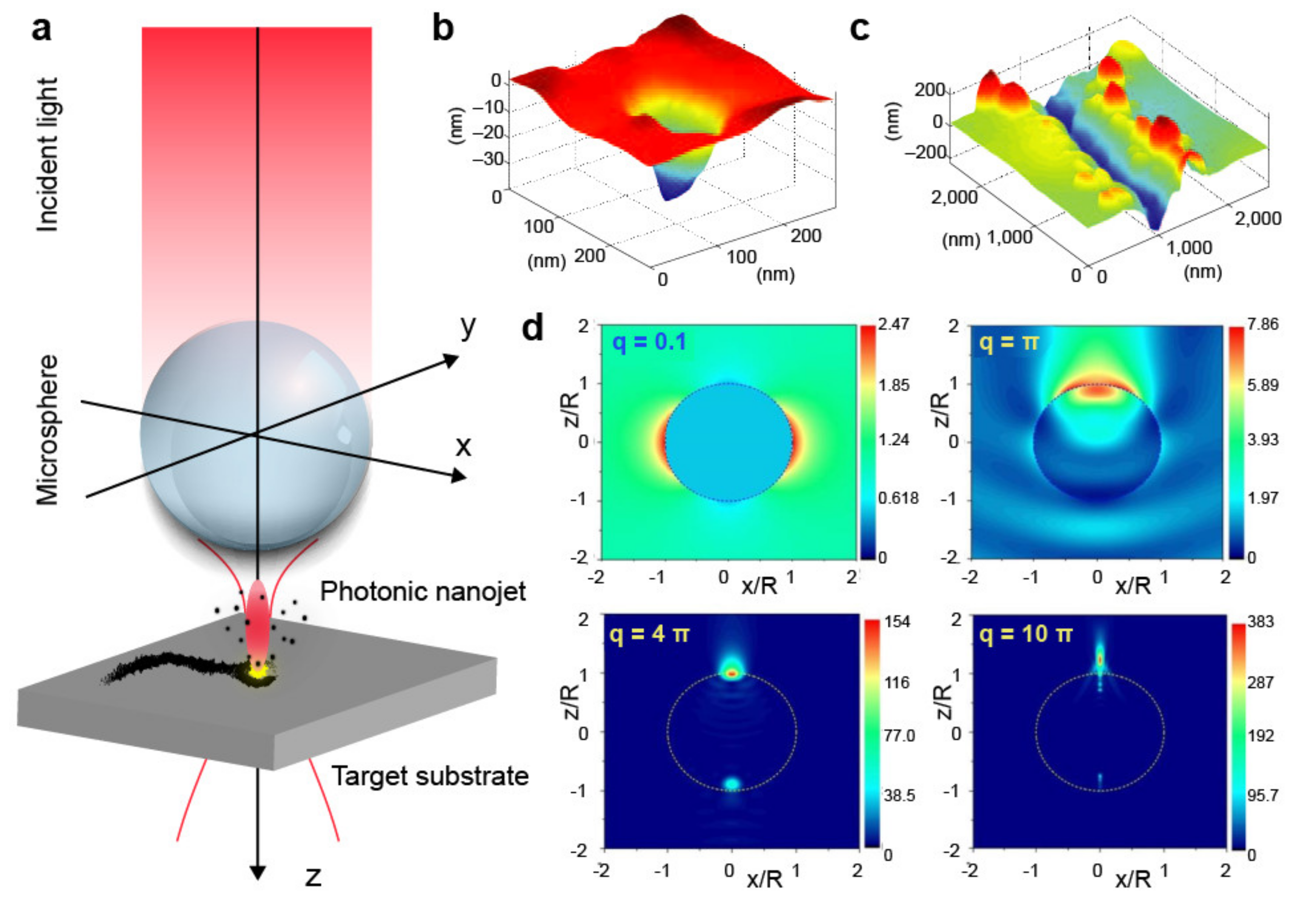
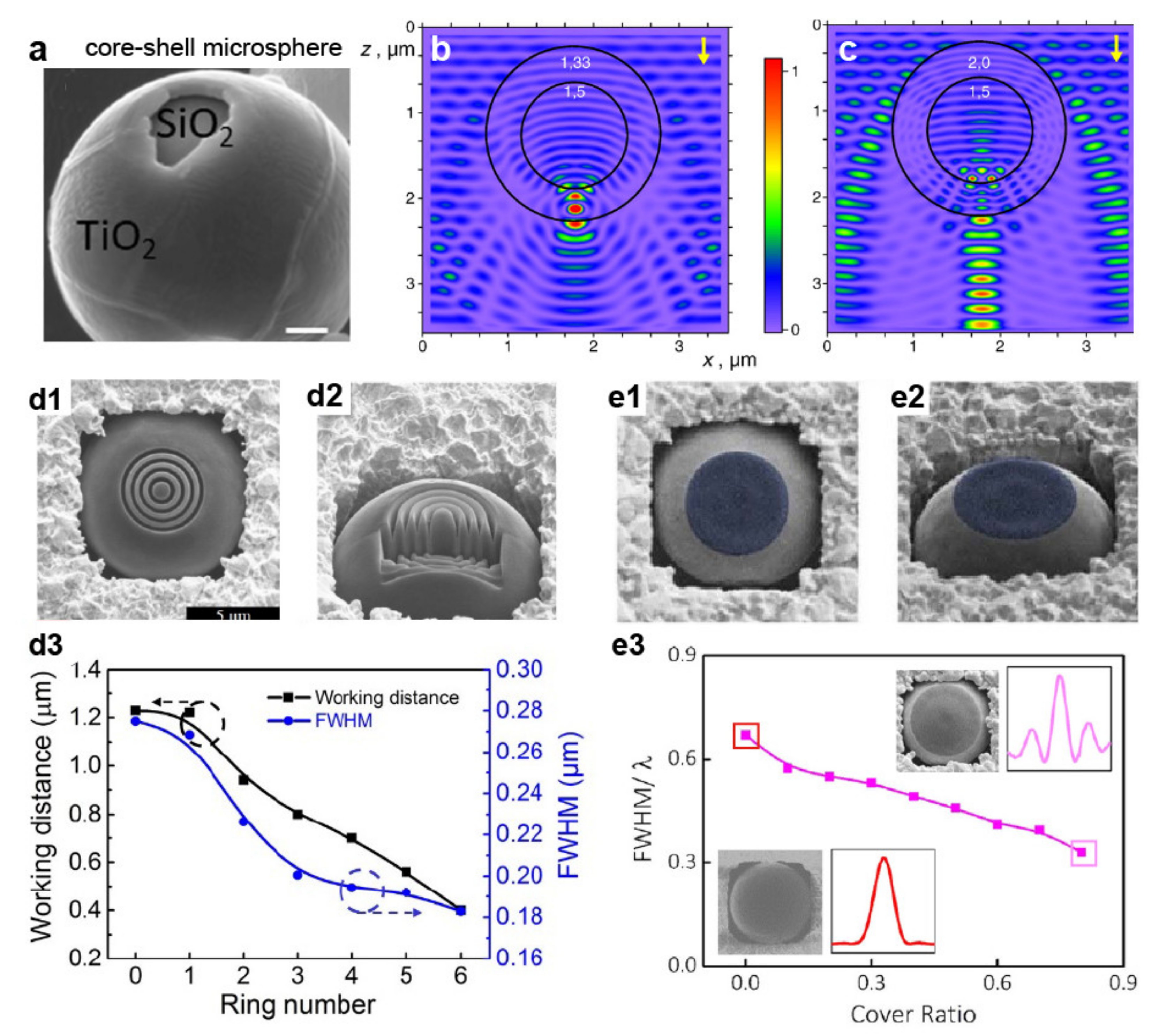
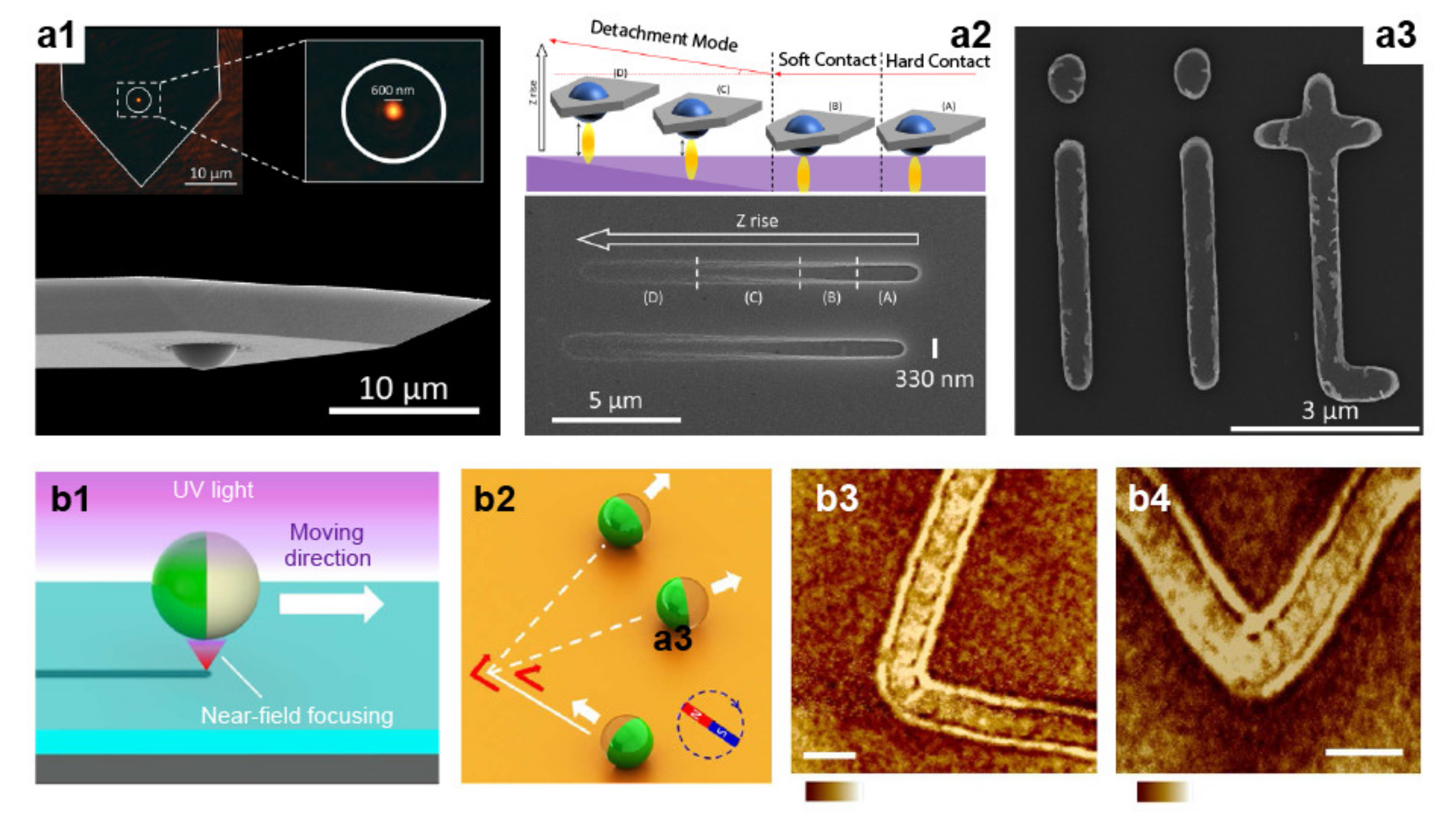
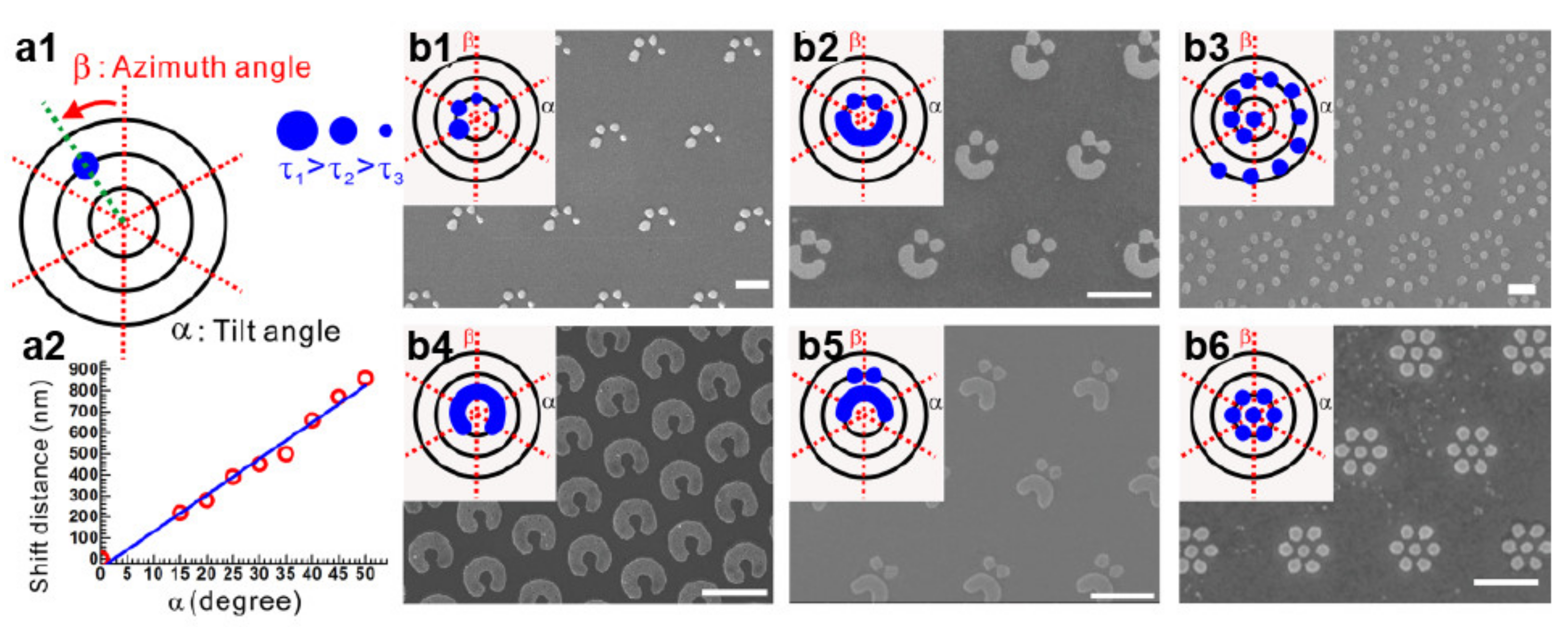
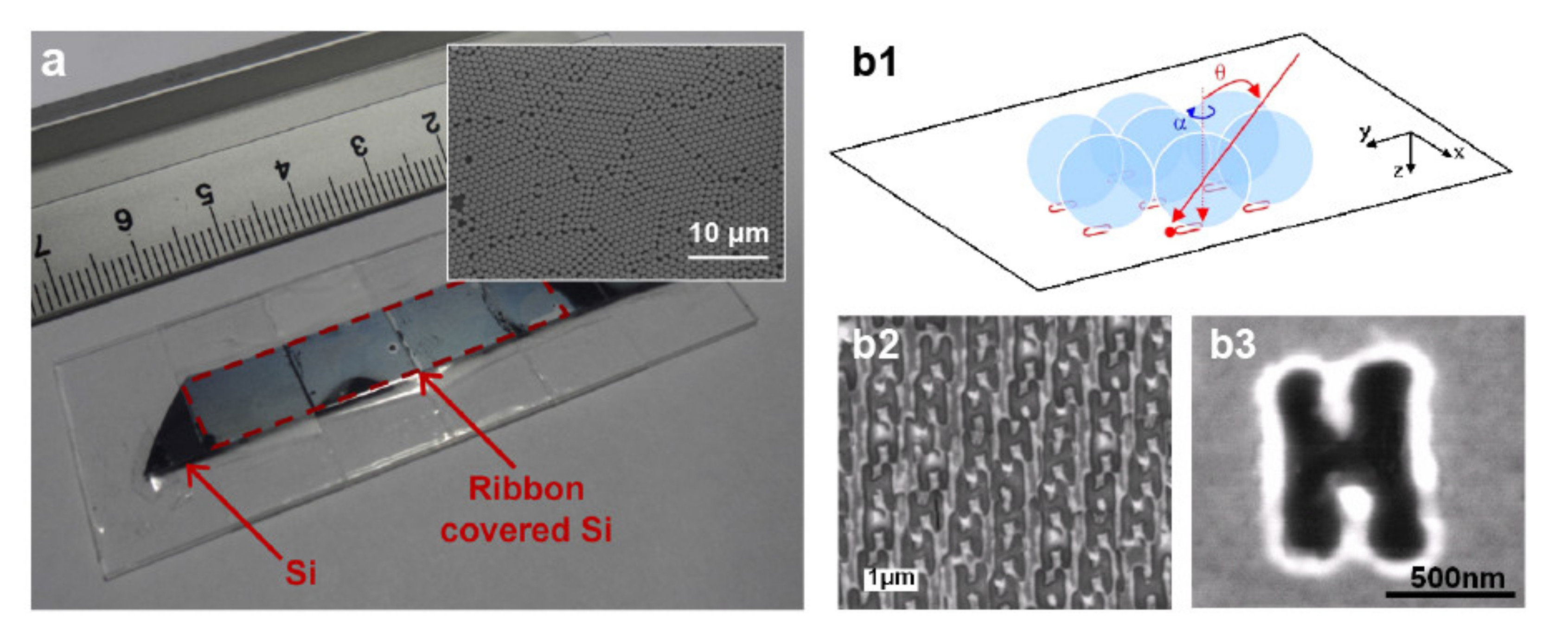

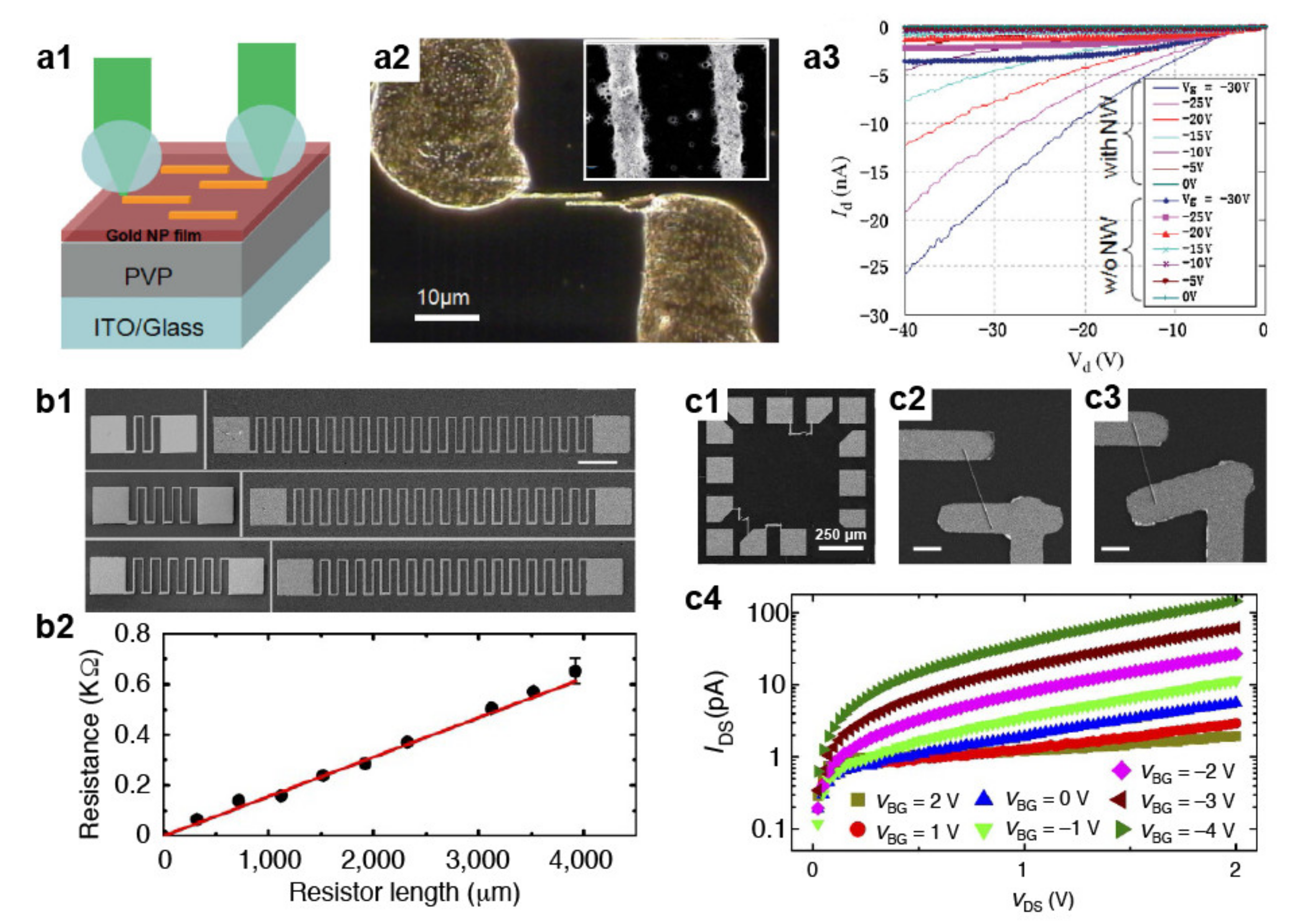
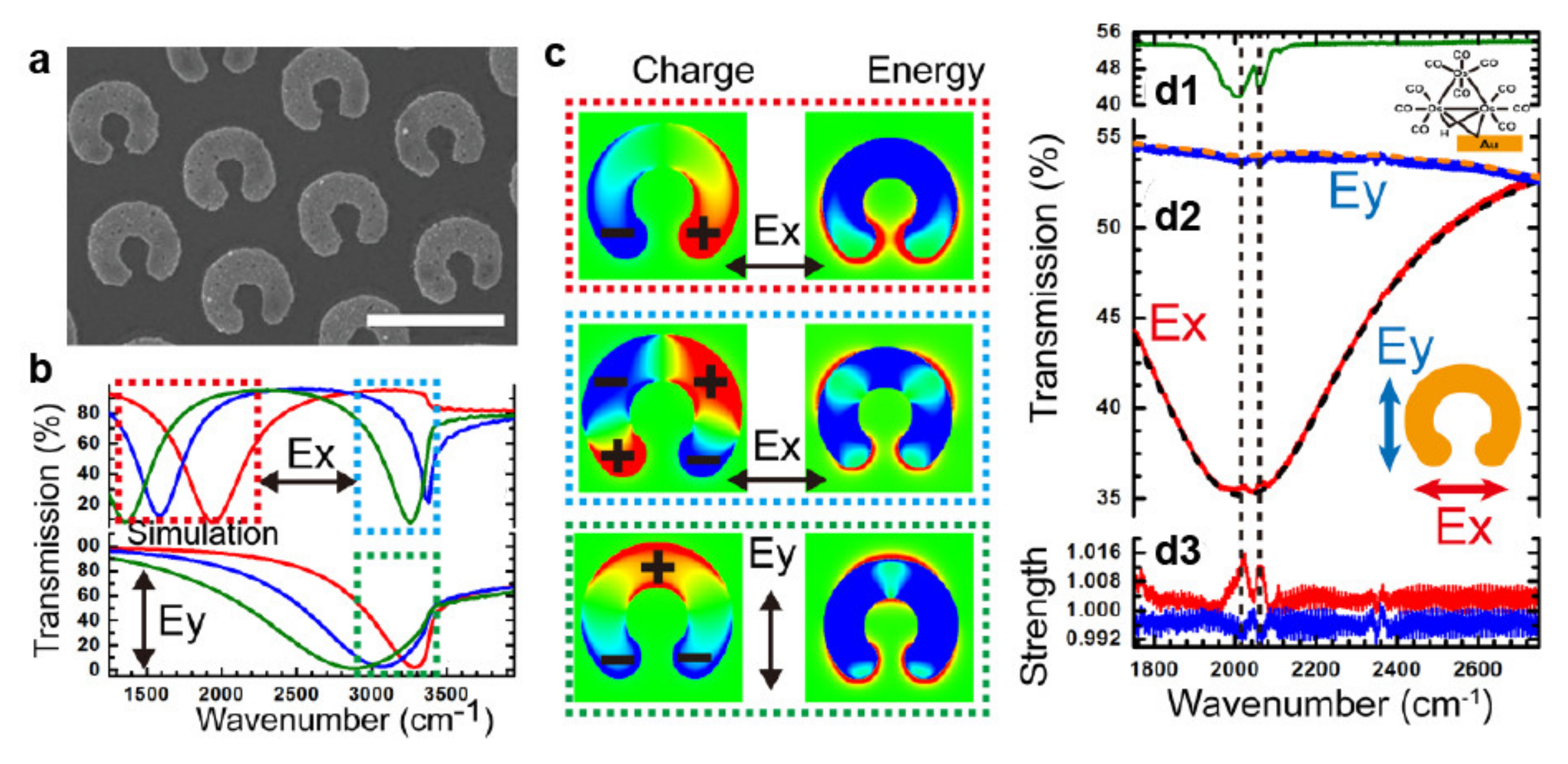
Publisher’s Note: MDPI stays neutral with regard to jurisdictional claims in published maps and institutional affiliations. |
© 2021 by the authors. Licensee MDPI, Basel, Switzerland. This article is an open access article distributed under the terms and conditions of the Creative Commons Attribution (CC BY) license (http://creativecommons.org/licenses/by/4.0/).
Share and Cite
Surdo, S.; Duocastella, M.; Diaspro, A. Nanopatterning with Photonic Nanojets: Review and Perspectives in Biomedical Research. Micromachines 2021, 12, 256. https://doi.org/10.3390/mi12030256
Surdo S, Duocastella M, Diaspro A. Nanopatterning with Photonic Nanojets: Review and Perspectives in Biomedical Research. Micromachines. 2021; 12(3):256. https://doi.org/10.3390/mi12030256
Chicago/Turabian StyleSurdo, Salvatore, Martí Duocastella, and Alberto Diaspro. 2021. "Nanopatterning with Photonic Nanojets: Review and Perspectives in Biomedical Research" Micromachines 12, no. 3: 256. https://doi.org/10.3390/mi12030256
APA StyleSurdo, S., Duocastella, M., & Diaspro, A. (2021). Nanopatterning with Photonic Nanojets: Review and Perspectives in Biomedical Research. Micromachines, 12(3), 256. https://doi.org/10.3390/mi12030256





